Plant asparagus once, and it’s the gift that keeps on giving… for 20 to 30 years!
That’s practically reaching heirloom status… Imagine passing down your asparagus bed to your kids one day?!
So when I finally had the space to grow asparagus in our garden, I wasted no time getting started.
Why? Because even with the best fertilizer and care, asparagus takes a few years to fully hit its stride.
Being a perennial vegetable, asparagus also need a dedicated, permanent plot in your yard where no other plants will go. Unlike many other crops, they don’t want companions and especially hate competition from grasses and weeds.
If you grow asparagus in a tall raised bed—by far the easiest approach—you’ll eliminate all of the digging, mounding, crouching, kneeling, and weeding that traditionally grown asparagus requires. A raised bed also helps the soil warm up faster in spring, so your asparagus will come up faster too.
Related: How to get more out of your garden by doing less—my tips for the lazy gardener
Here’s how I recommend planting asparagus if you want an easy, low-maintenance method.

When to buy asparagus plants
Asparagus crowns are only available once a year in early spring, so you have a short window to order or bring them home. Many reputable online suppliers even sell out in early spring, so start looking at their inventory in winter (when you’re also browsing seed catalogs) and place your order ahead of time.
Mail-order asparagus gets shipped according to your last frost date, so make sure you pick the correct delivery timeframe (which typically spans from March to May).
Read more: Use this custom planting calendar to help you find your first and last frost dates and plant at the right time
Brick-and-mortar nurseries, garden centers, and farm stores start carrying asparagus crowns when they’re ready to be transplanted, so if you find them locally, you can plant them right away.
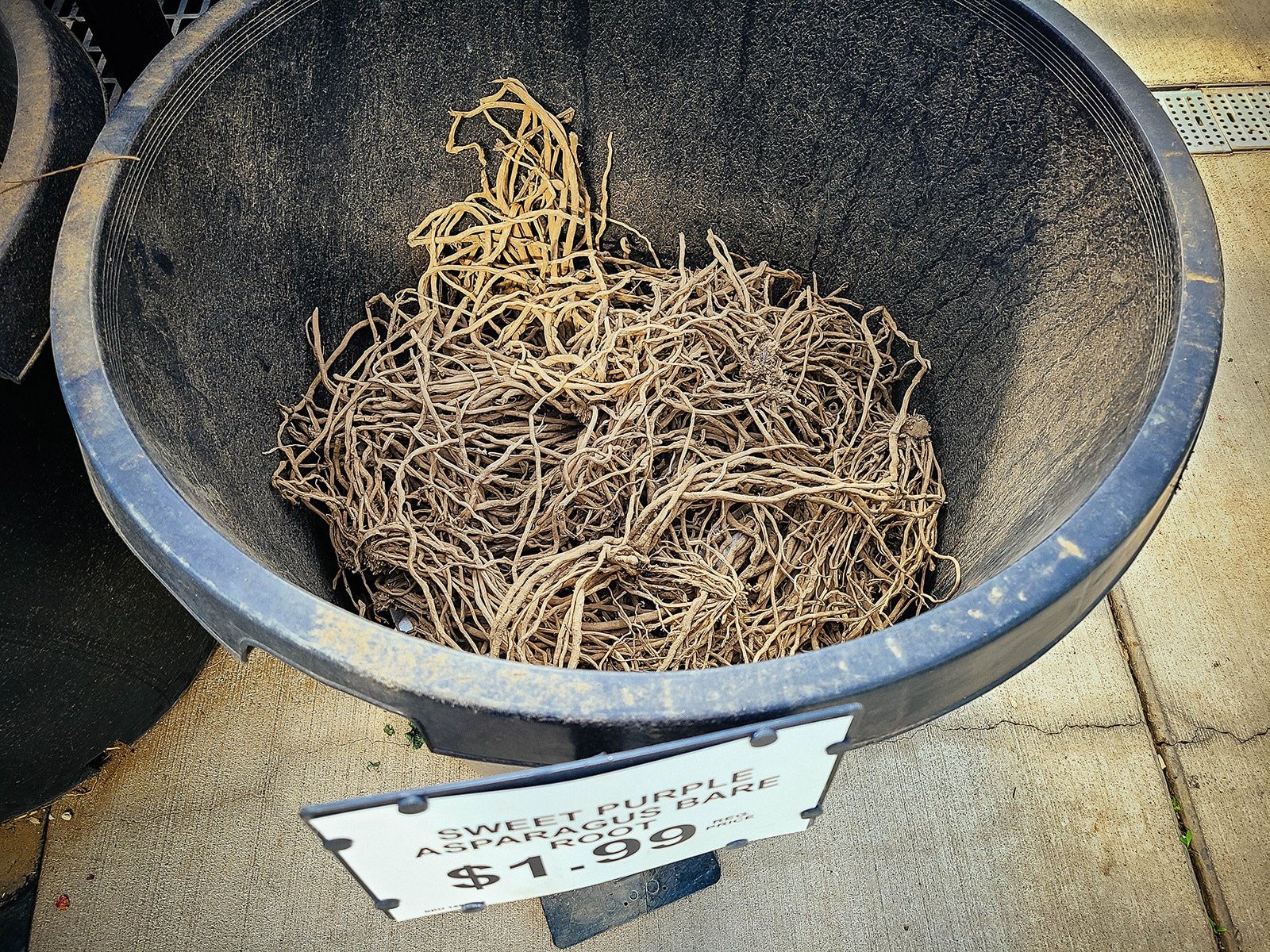
When you buy asparagus plants, you’ll typically receive one-year-old crowns like you see here.

This cuts down on the time you have to wait before you can harvest asparagus, and modern hybrid varieties are much easier to grow than heirlooms.
They look a little weird and gangly—kind of like spiders—and might not even look like they’re alive, but get them in the ground and they’ll spring up quickly.
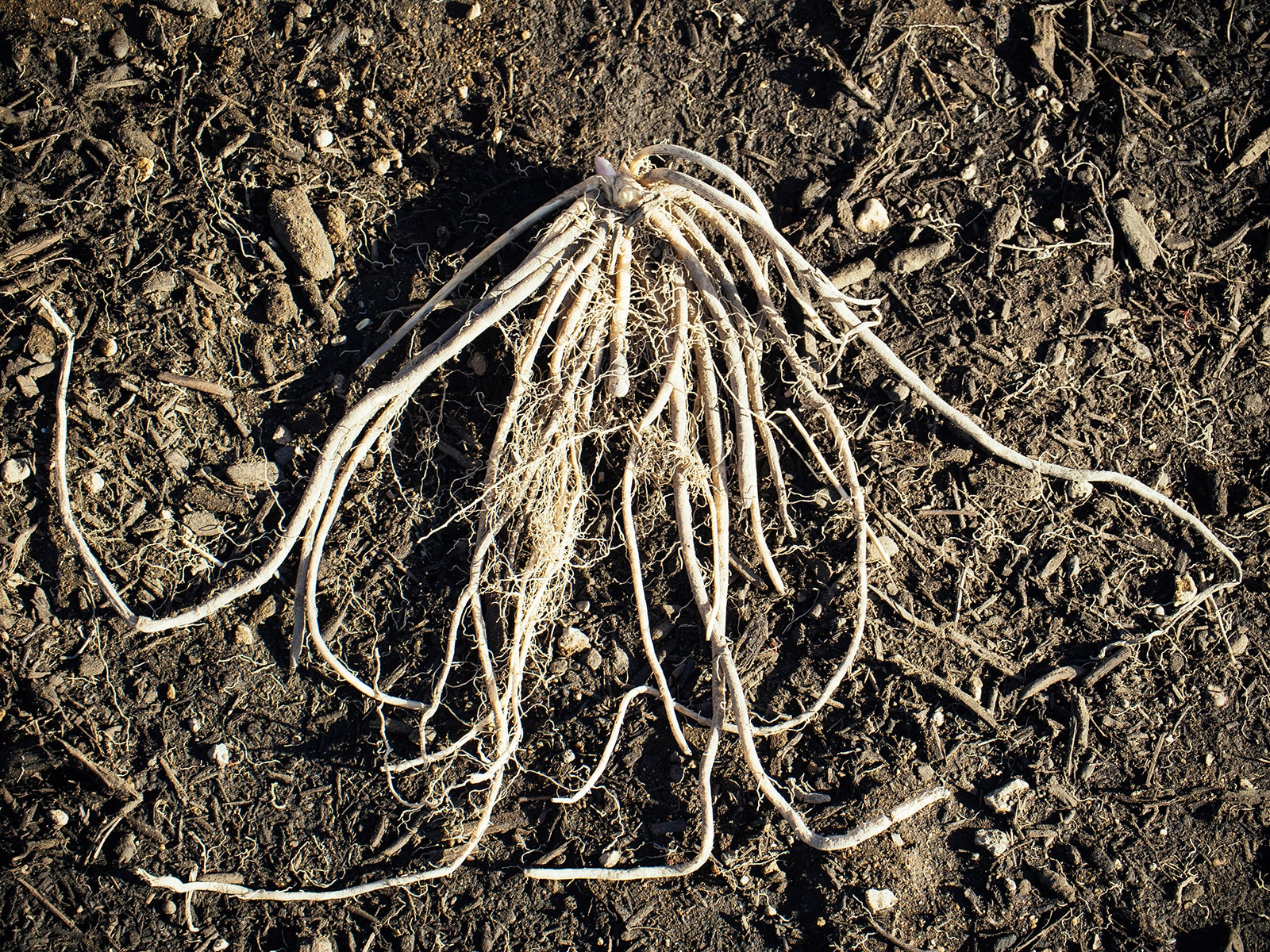
Disclosure: If you shop from my article or make a purchase through one of my links, I may receive commissions on some of the products I recommend.
Should you start asparagus from seed?
You could, but it’s just as easy to find asparagus crowns as it to find seeds, and you have a higher rate of success with crowns.
Not to mention, old-world cultivars like Martha Washington and Mary Washington (which are also available as seed) are fussier to grow than improved F1 hybrids like Jersey Knight and Millennium.
These modern hybrid varieties are less work to plant and they produce nearly twice as many spears per plant, since they’re bred to be predominantly male (which means the plants don’t waste energy on producing seeds and baby plants). They also tend to maintain tight tips, even if you’re a little slow to harvest.
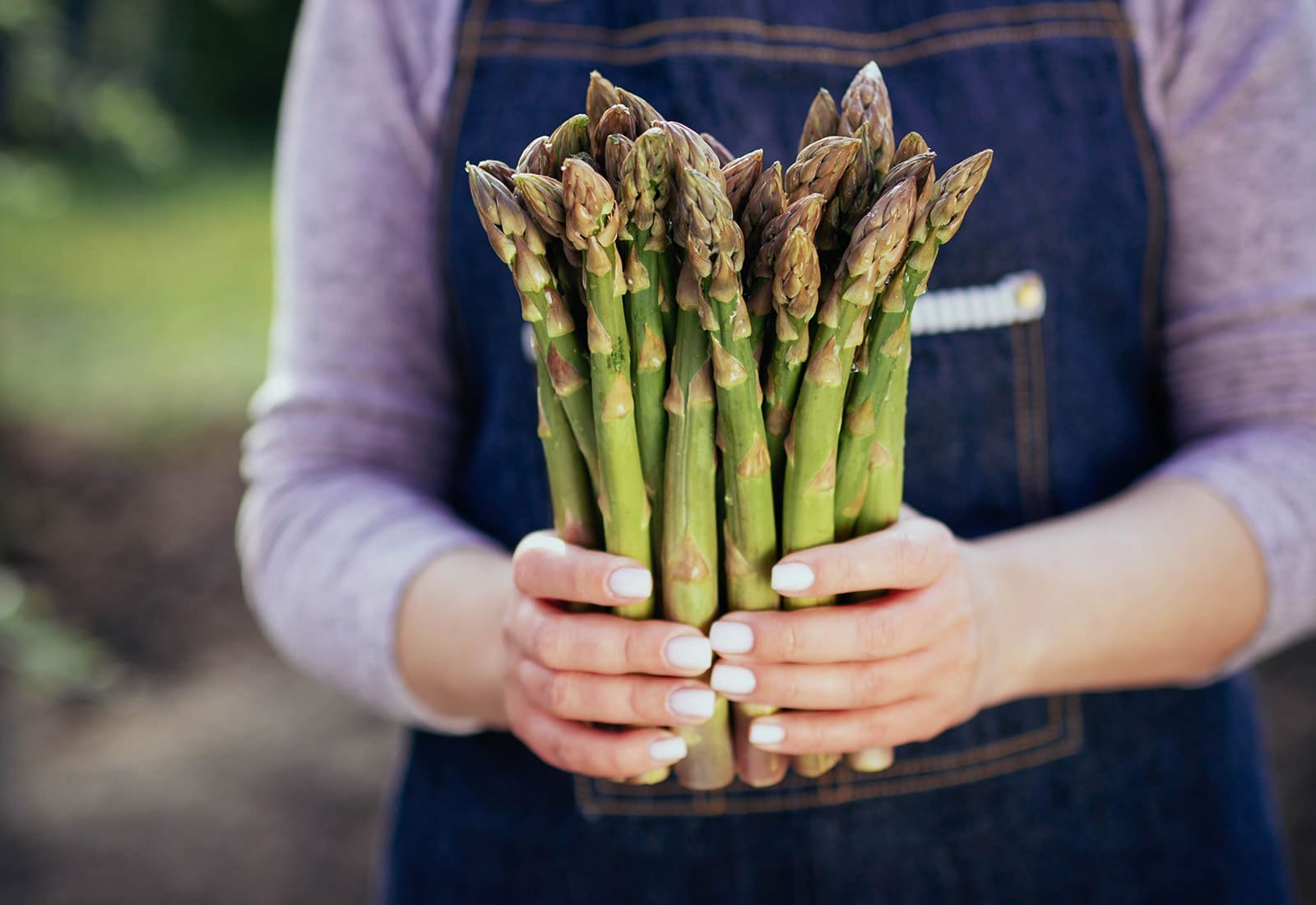
With vigorous hybrids like the Jersey series (Jersey Knight, Jersey Supreme, and Jersey Giant), you only need 25 to 30 plants to feed a family of 4… unless you really love asparagus or plan to freeze or pickle them later, then the more the merrier.
Otherwise, the typical recommendation for growing an open-pollinated asparagus variety (like Martha Washington) is up to 10 plants per person—so you’d need a lot of real estate to devote to a single crop.
Read next: How much to plant in a vegetable garden to feed a family
Personally, I devote three-quarters of my asparagus bed to Purple Passion crowns, which produce both male and female plants. They work very well in my Zone 5 microclimate because the purple spears emerge later than standard green varieties, protecting them from our late spring frosts, and they’re a bit sweeter too.
The remaining space in my bed is filled with Jersey Knight asparagus, so I get the best of both worlds as far as flavor and production.
Get the PDF
Want to download this article with no ads?
You can get this entire article emailed to you as a PDF to read at your convenience! Simply save it to your device or print it out for easy reference.
How to plant asparagus in a raised bed
Once asparagus gets established, it doesn’t really like to be moved again. So find a good permanent spot in your garden (keeping in mind that asparagus ferns can grow up to 5 feet tall in a single season) to avoid transplanting the whole crop later.
Asparagus can be planted as soon as the soil is workable and your average last frost date has passed.
If the crowns look and feel a bit brittle (which is usually the case with store-bought asparagus that’s displayed in a big basket or tub), soak them in a bucket of water to rehydrate them before planting. You can do this while you prep the soil—just don’t leave the crowns in water for longer than an hour, as that can encourage rot.

Soil preparation
Choose a planting site on the northern or western side of a garden so mature asparagus plants won’t shade other vegetables in summer.
Start with well-draining soil that’s about 8 inches below the rim of your bed.
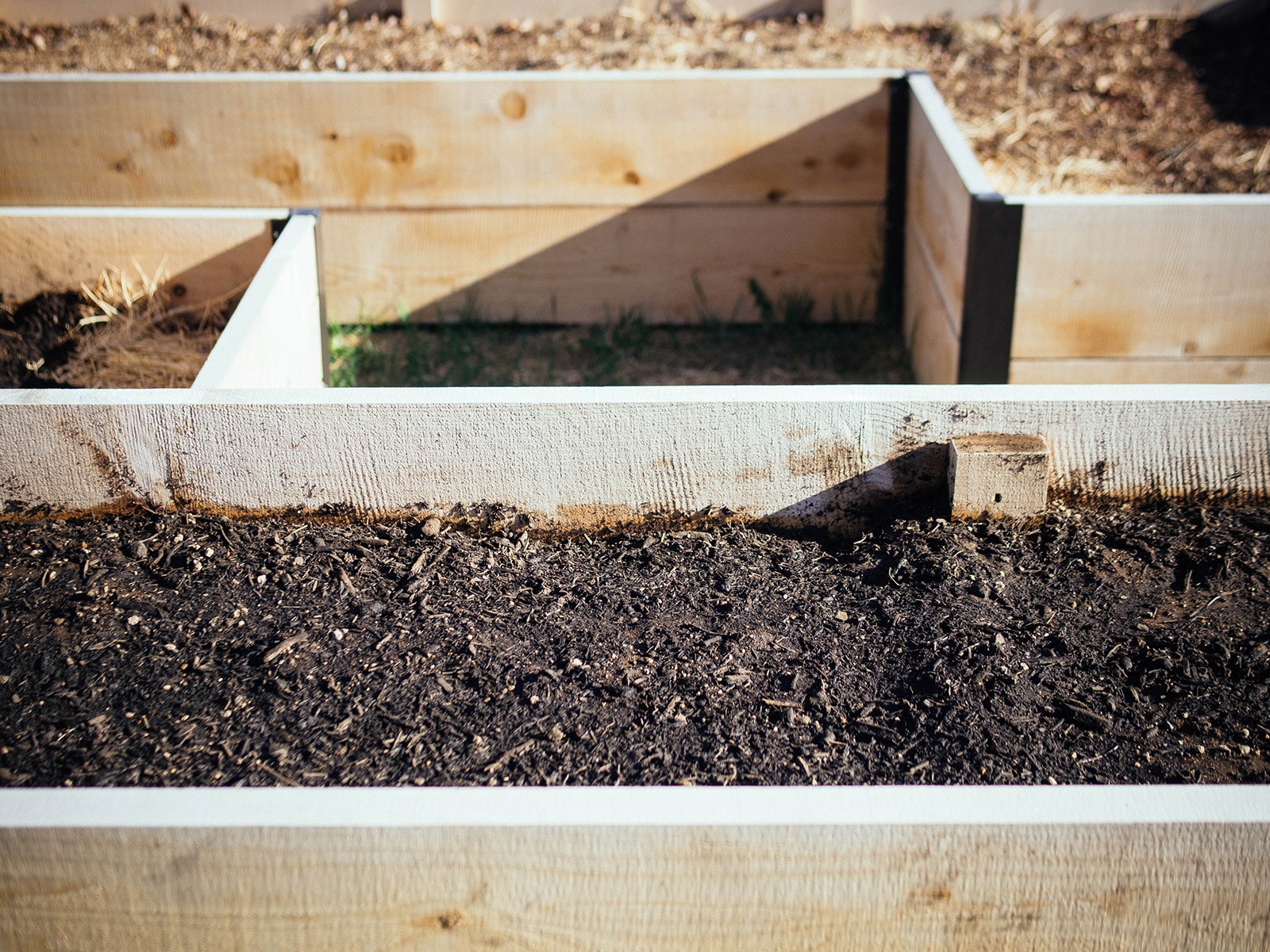
That means your raised bed needs to be at least 12 inches high to give the roots room to grow, though I recommend building a bed up to 24 inches high for easy harvesting. (My own asparagus bed is 36 inches high! And my back thanks me for it every season.)
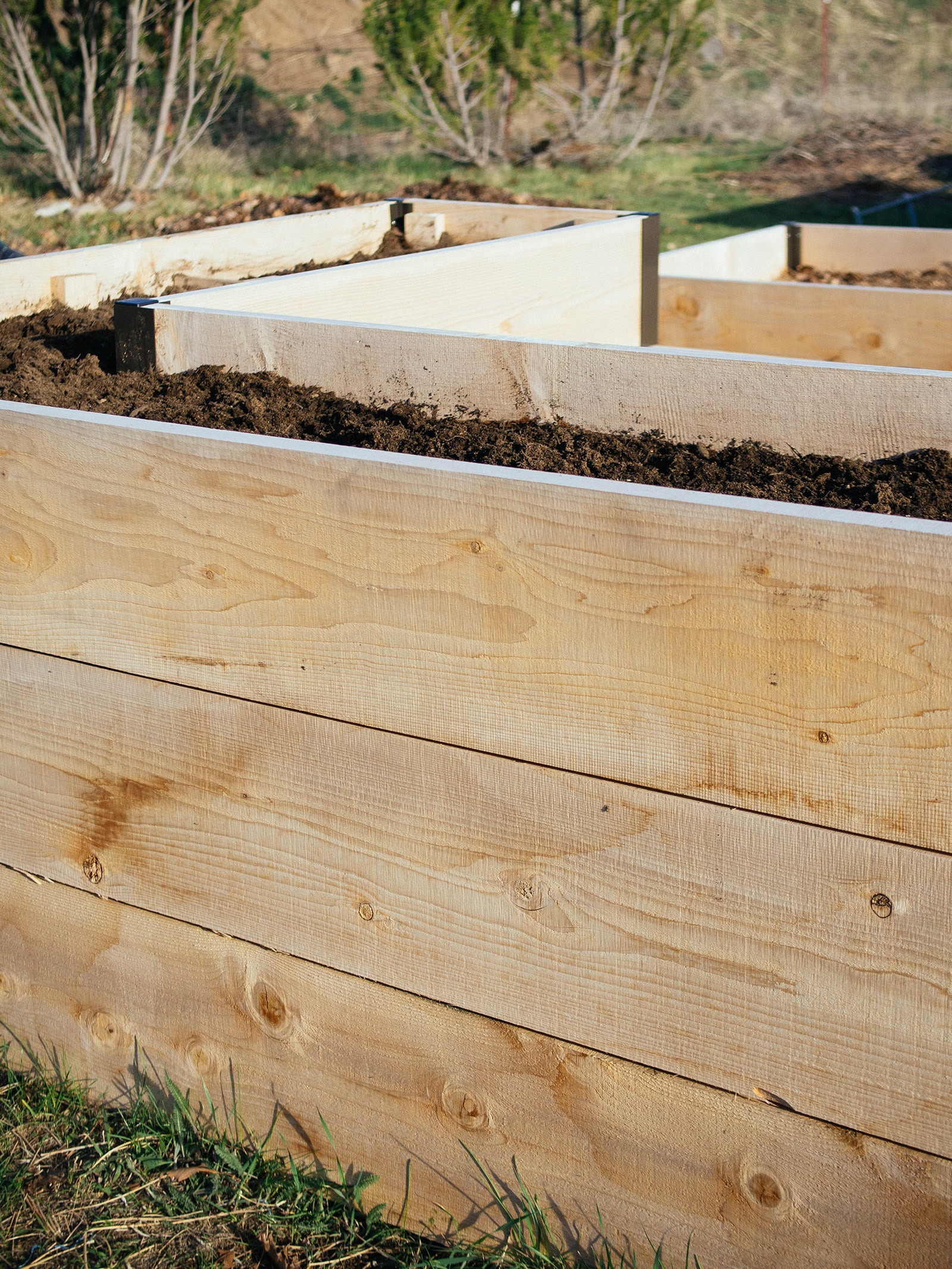
Clear the area of any weeds, and amend the soil with 2 inches of well-aged compost.
Mix in an organic all-purpose fertilizer, following the package directions. The best option, if you can find it, is an organic fertilizer that has higher levels of phosphorus and potassium. (These are the P and K values in NPK.)
Phosphorus promotes strong root growth so it’s especially important for asparagus in early spring. Potassium is needed for healthy crop production as it helps the plants develop sturdy stems (the part we eat, otherwise known as asparagus spears).
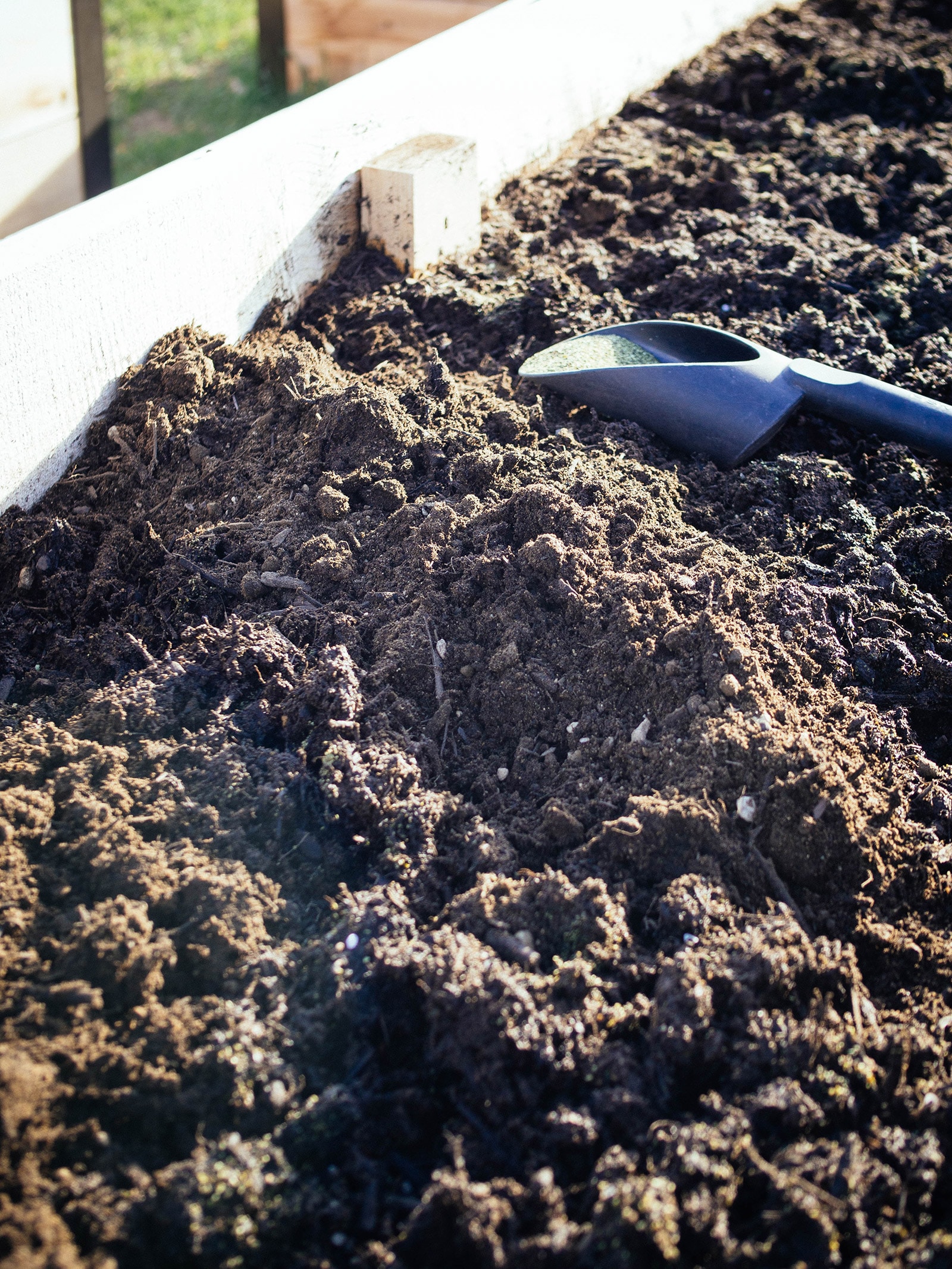
I also like to add kelp meal before planting. This organic amendment contains growth hormones that aid in root and shoot development, as well as trace minerals not found in NPK fertilizers.
I recommend this specific fertilizer from Dr. Earth or this one from Espoma (don’t mind what they’re called, just look at the ingredients), plus a dose of kelp meal to get your plants off to a great start.
Planting
Most asparagus planting guides call for digging trenches and making mounds, but in a raised bed, you can skip all that work!
Place the crowns 12 inches apart and spread the roots out around them.
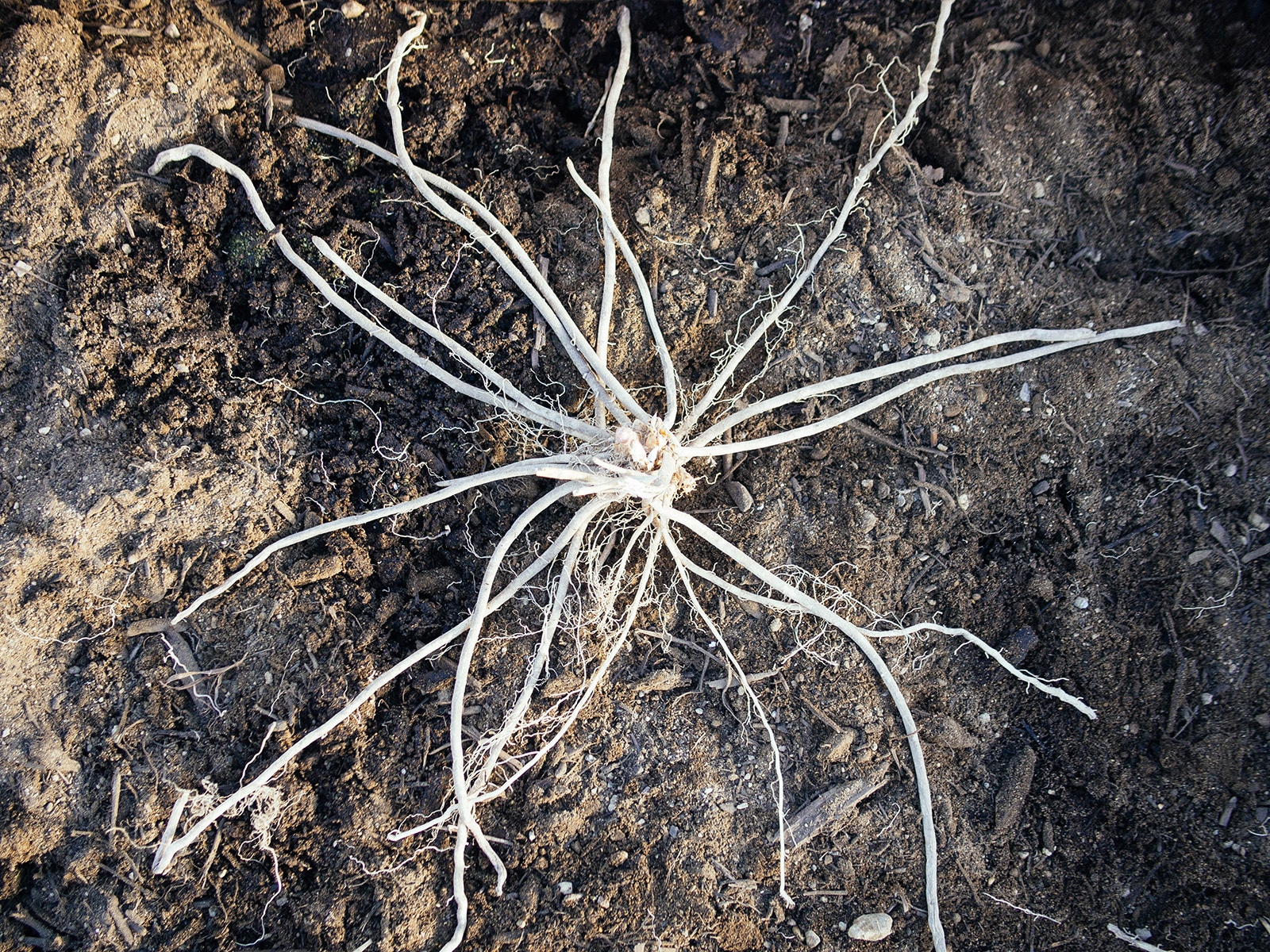

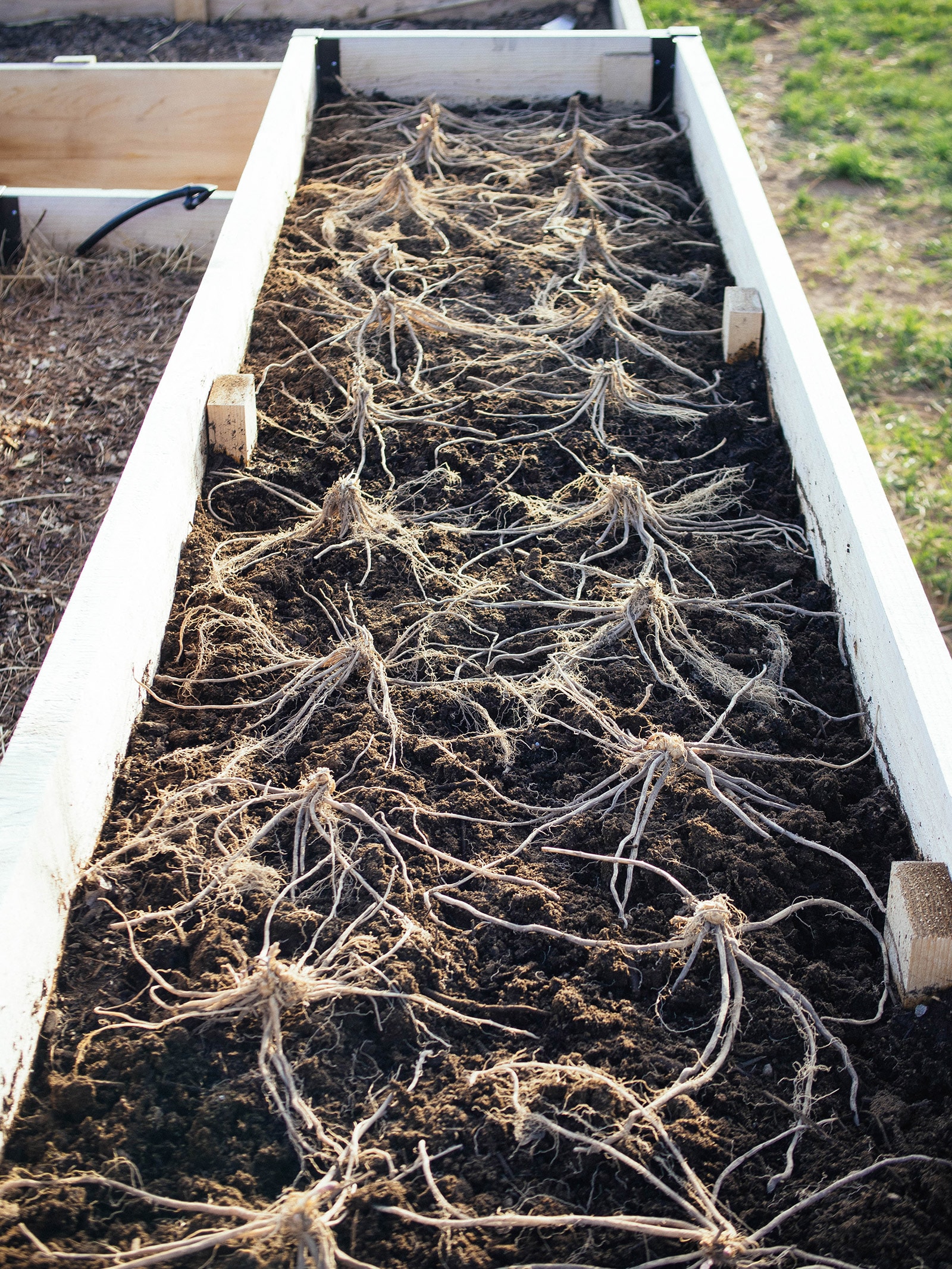
Make sure the crown is facing up. It’s the little nub that sits above the roots, and it’s where the asparagus will grow from. Sometimes, there will even be tiny spears sprouting already.
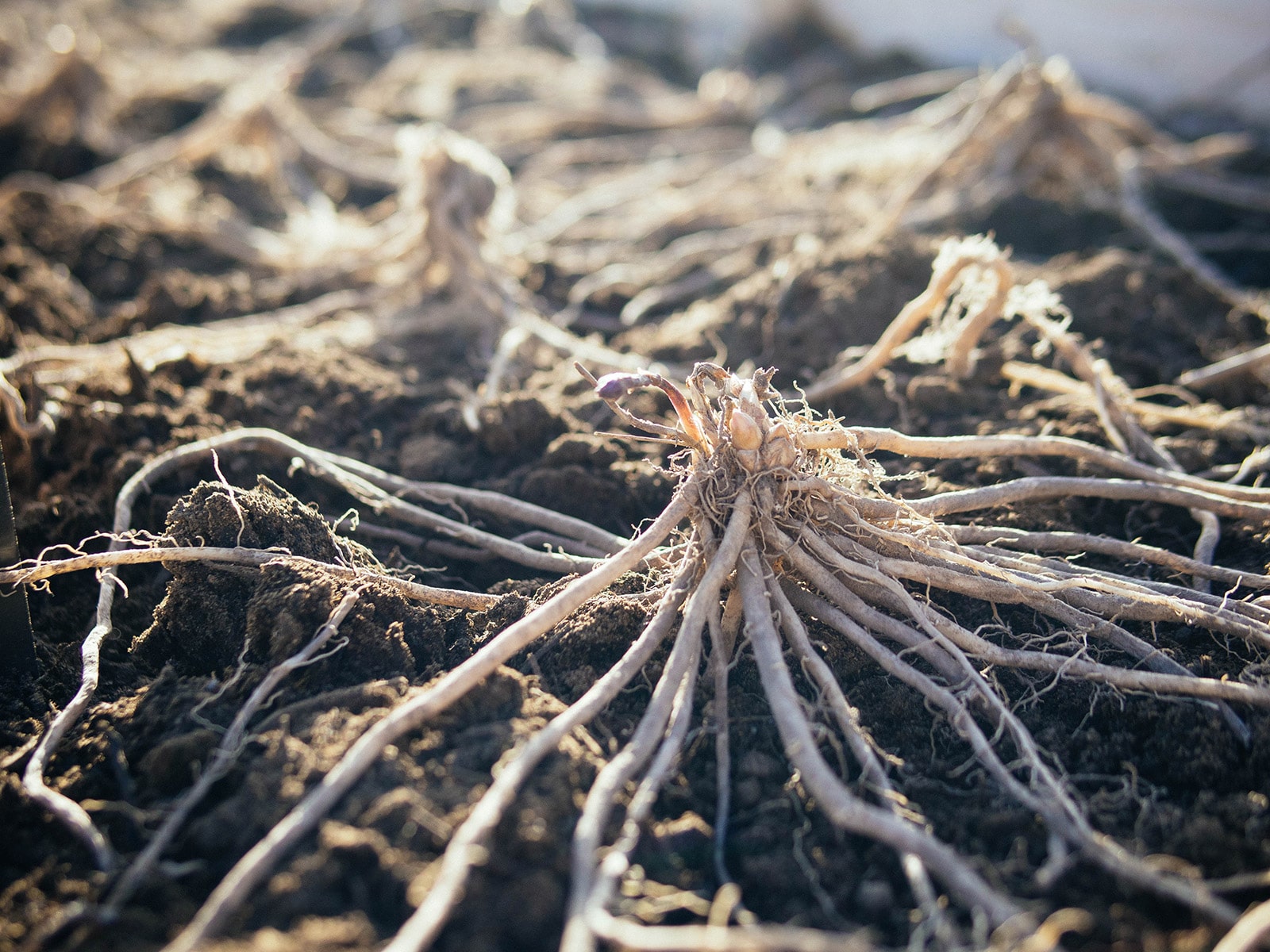
Cover the asparagus with about 3 inches of soil.
Once the asparagus starts growing and the spears are a few inches tall, add another 3 inches of soil (taking you to the top of your bed—the crown should be 6 inches below the surface now). Then for the rest of the season, keep the weeds down with a 2-inch layer of mulch.
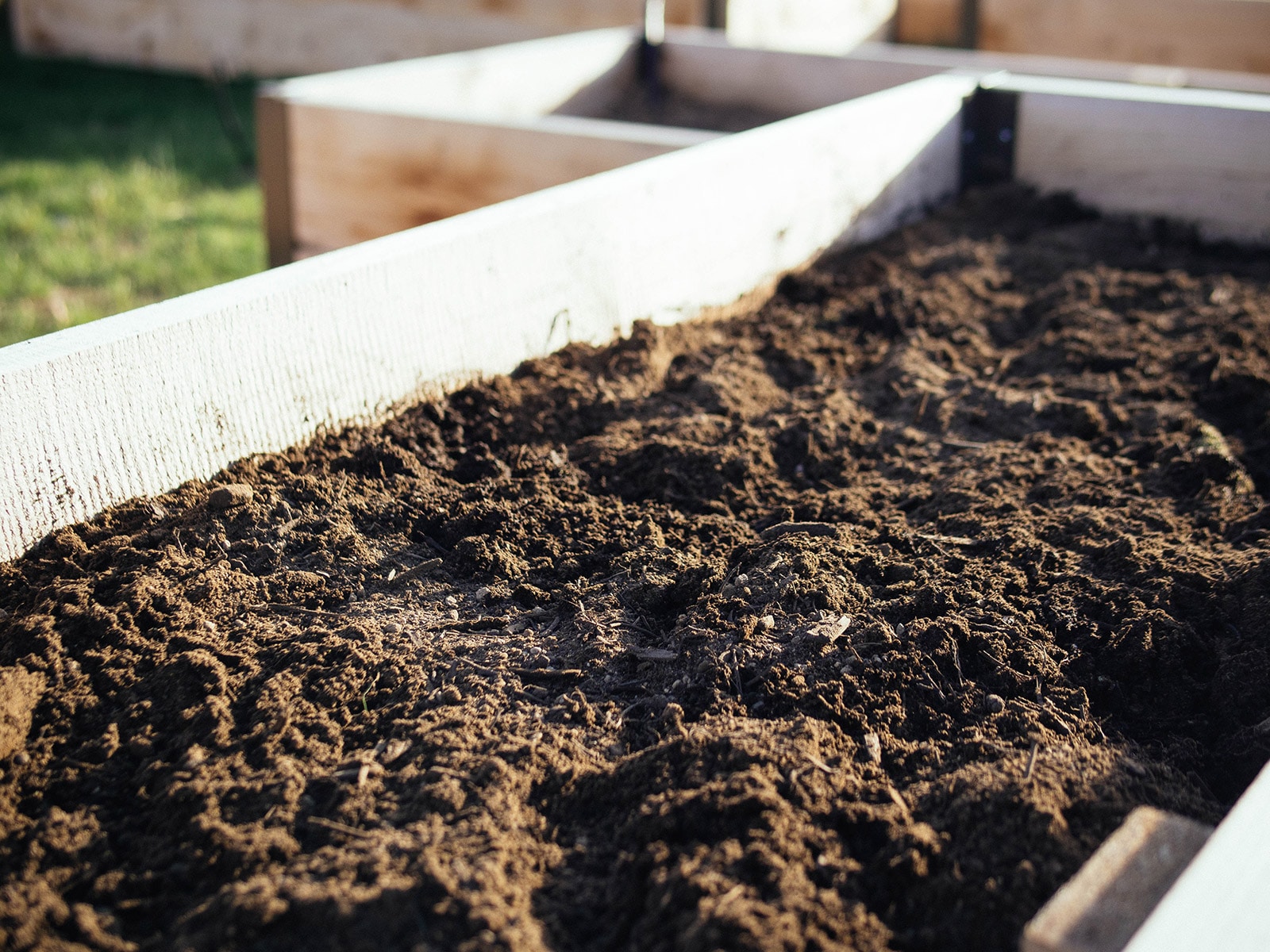
Watering
During the first two years, asparagus needs regular watering (about 1 to 2 inches of water per square foot per week). Once established, the plants need only 1 inch of water per week.
As the plants get older, they become fairly drought-tolerant and usually grow well with rainfall as the sole water source (unless you live in a dry, hot climate).
Fertilizing
Asparagus is unique in that it’s fertilized in the beginning of the season, before the first shoots appear, and then fertilized mid-season (in June or July) after you’ve finished harvesting. This helps the fronds grow lush and healthy, which encourages massive yields the following year.
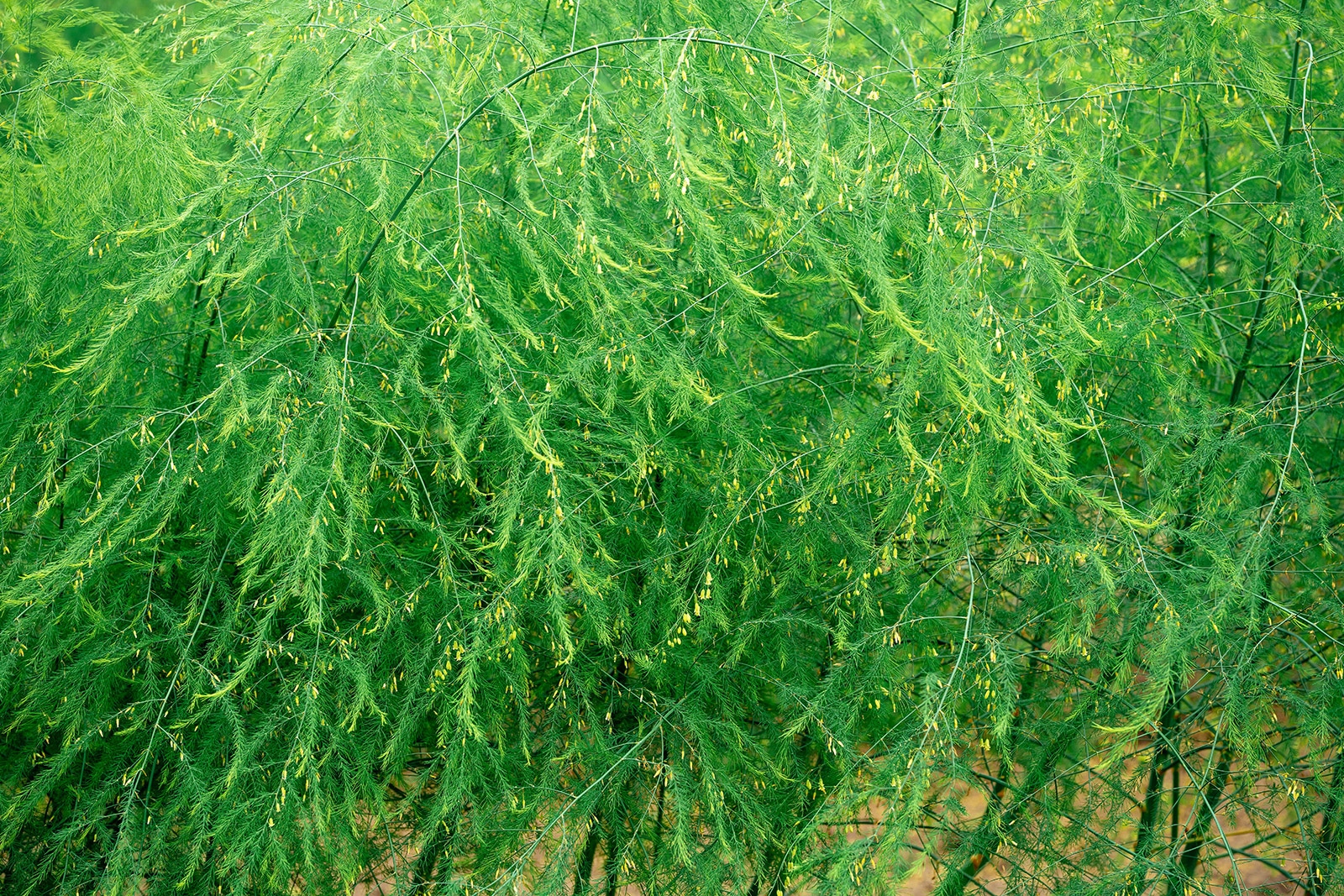
To keep nutrient levels high, you can apply the same organic fertilizer you mixed in during the initial soil prep (like these ones from Dr. Earth or Espoma).
How to store asparagus crowns if you can’t plant them right away
If you got a shipment of asparagus crowns in the mail but you aren’t ready to plant them right away, open up the box so the crowns can breathe and keep them in a cool, dark place for up to a week.
If you need to store the crowns longer than a week, you have a few options depending on space and timeline.
For short-term storage (another week or so), wrap the bundles in slightly damp kitchen towels or newspapers, and stash the crowns in a cool, dark place (like a pantry, closet, or basement).
For longer-term storage, you can wrap the bundles in damp towels or newspapers (or place them in a loosely sealed plastic bag) and keep in your refrigerator for several weeks.
They might start sprouting during this period but as long they don’t dry out, the asparagus will survive. Ideal conditions are 40°F at 85 percent to 90 percent humidity.
Don’t let excess moisture accumulate on them (otherwise they’ll get moldy or rot). Periodically spray them with water if the roots look and feel dry, and plant them as soon as possible.
If your dedicated asparagus bed won’t be ready for a while, then it’s best to get the crowns in the ground temporarily.
You can plant them closer together than normal (6 to 8 inches apart) and transplant the asparagus next spring when they’re still dormant. Just be gentle when you lift the roots to move them into their permanent bed. They might suffer a little shock (and produce fewer spears that season), but should recover by the next year.
Be patient—don’t pick the first year
The first year, don’t harvest any asparagus. (I know, it’s tempting.)
The next year after you plant them, you can take a very light harvest (just one or two spears per plant, over a three- to four-week period).
The year after that (which would make your plants three years old), you can start picking asparagus regularly through the harvest season, which runs about six weeks (and sometimes up to eight weeks).
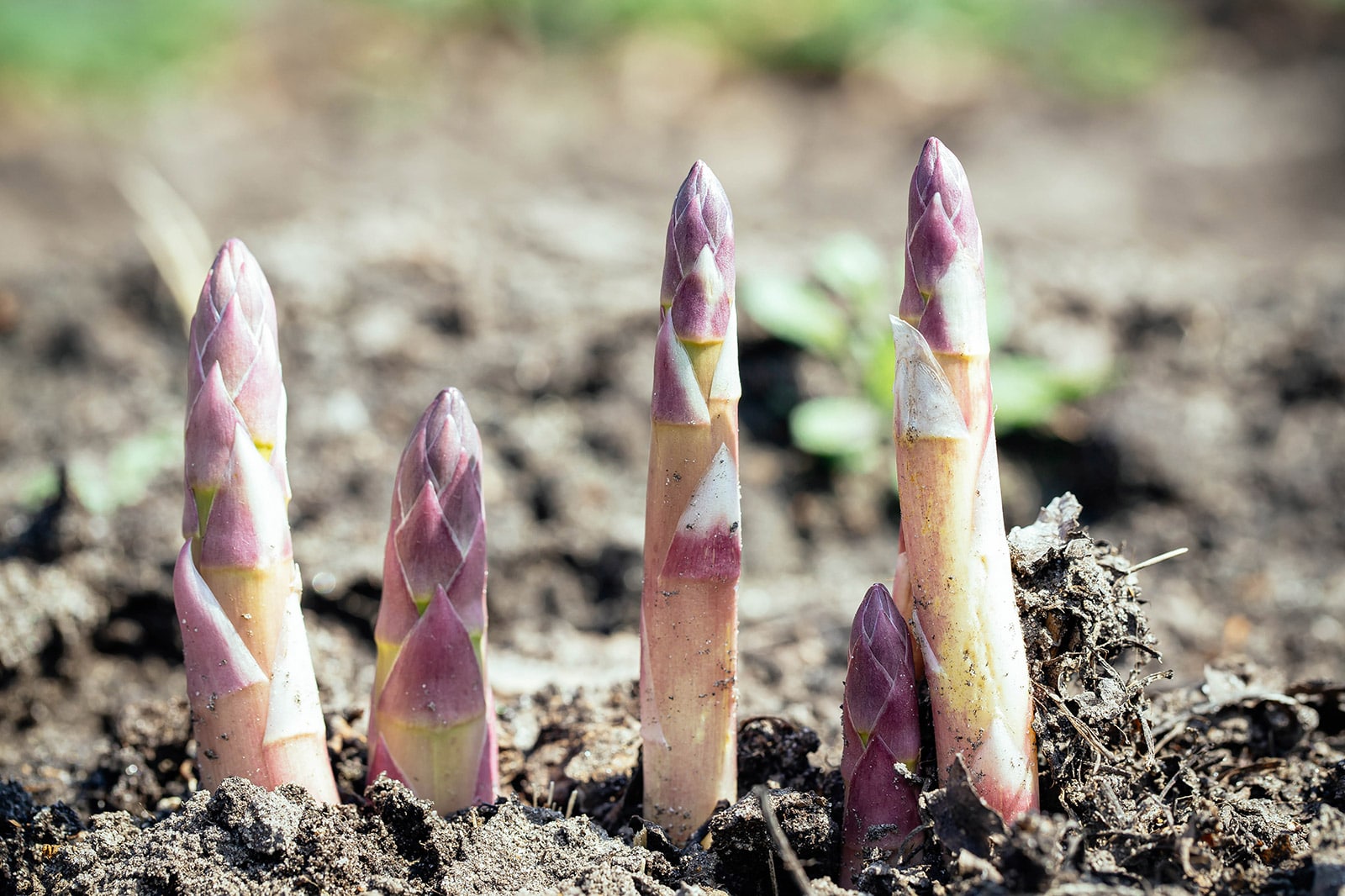
By not harvesting heavily during the first two years, you allow the crowns to be more productive over the life of the planting. It might sound counterintuitive compared to what you’re often told about other vegetables—that the more (and more frequently) you harvest, the longer your crop produces.
But when you allow asparagus fronds to unfurl and continue growing in the first two years, this helps the plants capture a greater amount of sunlight. All that energy goes into feeding the roots so the plants can develop a strong root system that supports an abundant crop of spears the following year.
I promise it’s worth the wait!
How to harvest asparagus
Harvest your asparagus when the spears are 5 to 7 inches tall and before the tips begin to loosen. (Once the tips loosen, the spears become tough and fibrous.) To harvest the spears, just cut or snap them off right above the soil level.
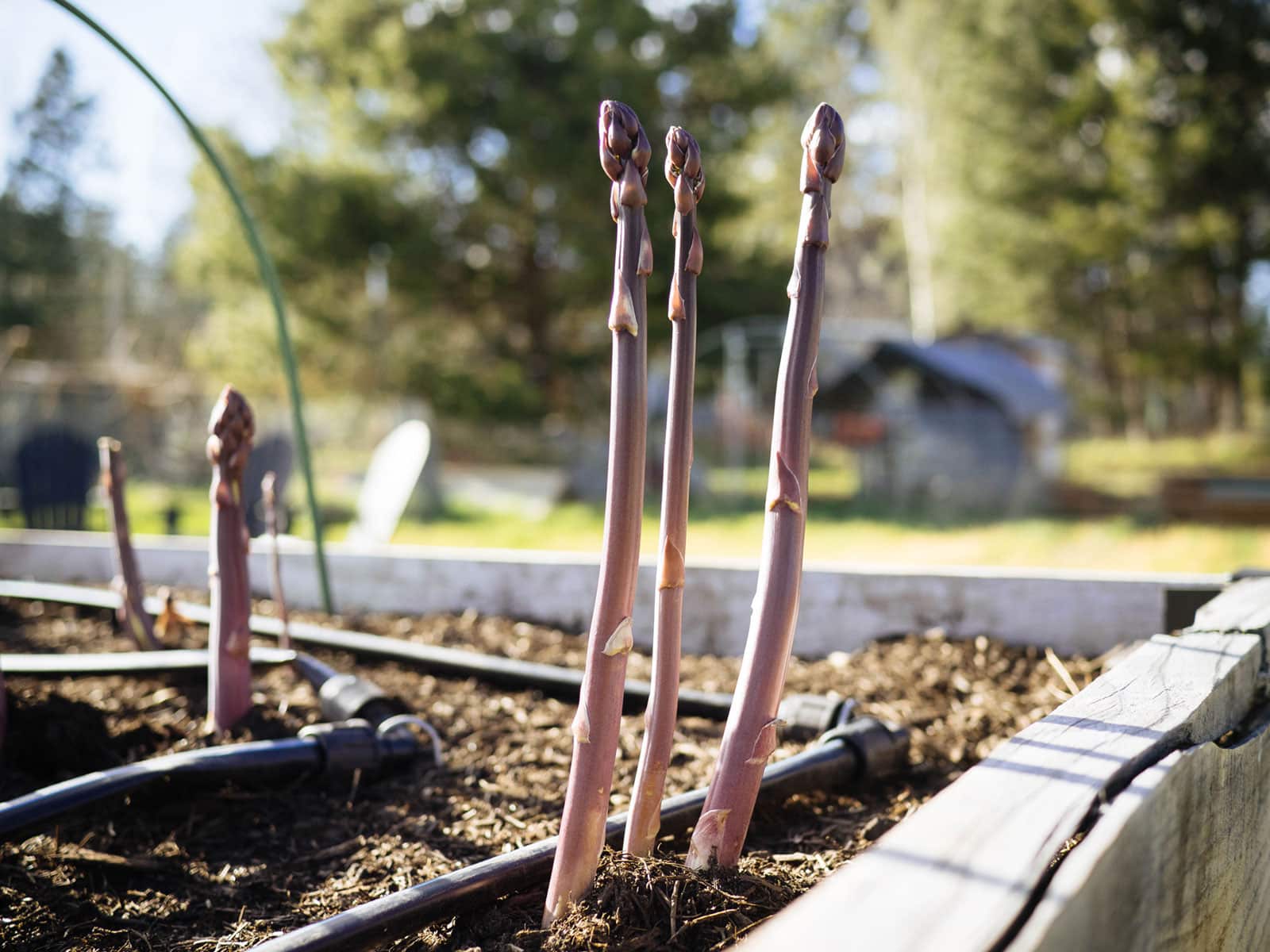
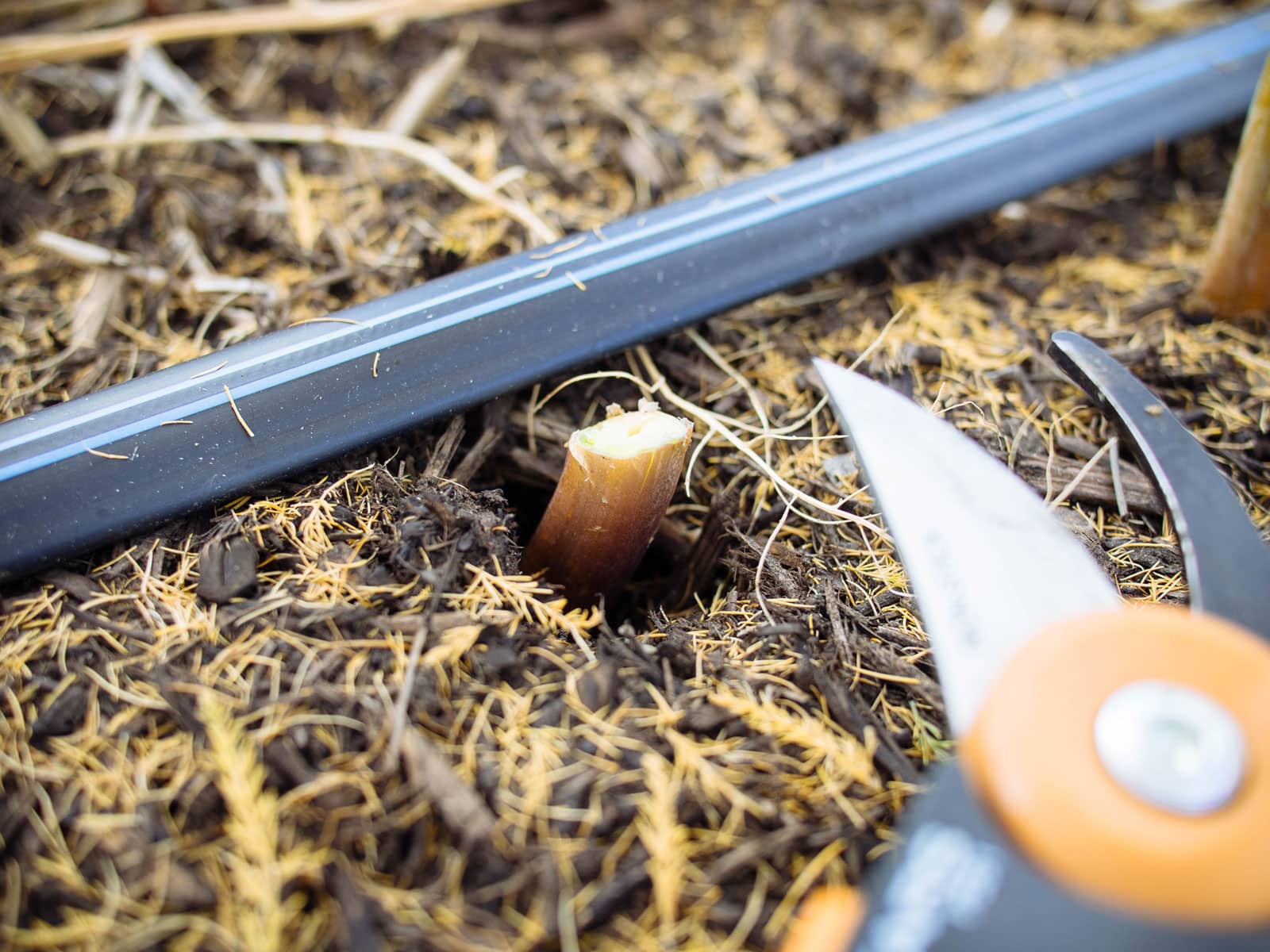
Once your asparagus bed is established in its third year, harvesting can continue until the bed produces only skinny spears that are less than half an inch in diameter.
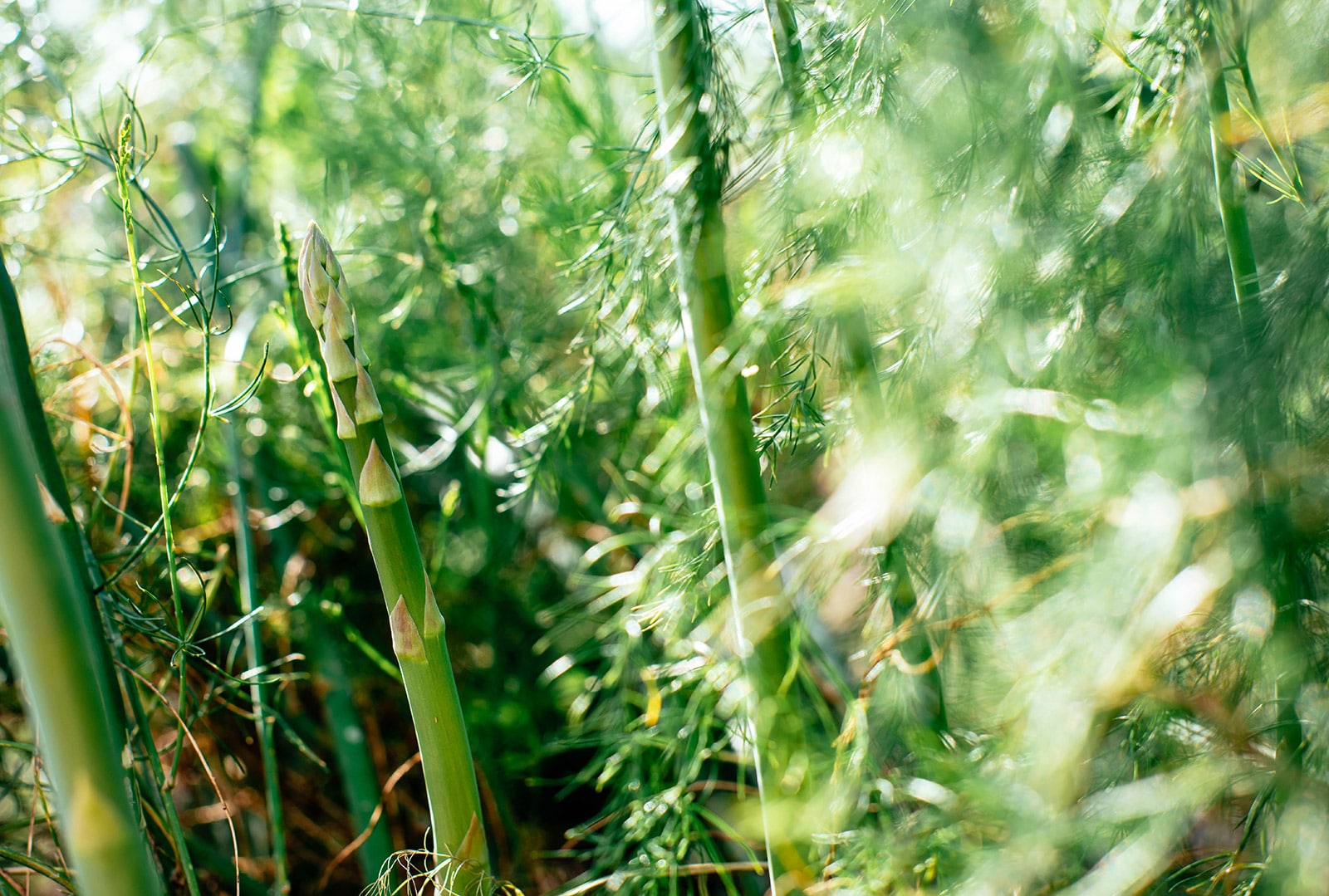
At that point (usually late spring to early summer), allow the spears to develop naturally. They’ll grow 3 to 5 feet tall with lacy, fern-like, feathery soft foliage. The healthier they are, the better your crop will be the following spring.
Food storage made easy
Don’t let good food go to waste!
Download my Fruit & Vegetable Storage Guide for printable charts, helpful tips, and secret tricks for keeping your produce super fresh for as long as possible.
How to prepare the bed for winter
After the fronds turn brown in fall, you have a few options:
- Let the dead foliage stand over winter (and cut it down in early spring before new growth appears).
- Cut down the dead foliage right at soil level, then spread the brittle stems across your asparagus bed as a winter mulch. (This is what I do every year.)
- Or cut the dead foliage down at the base of the plants before winter, and remove it to keep pests (like asparagus beetles) from overwintering.
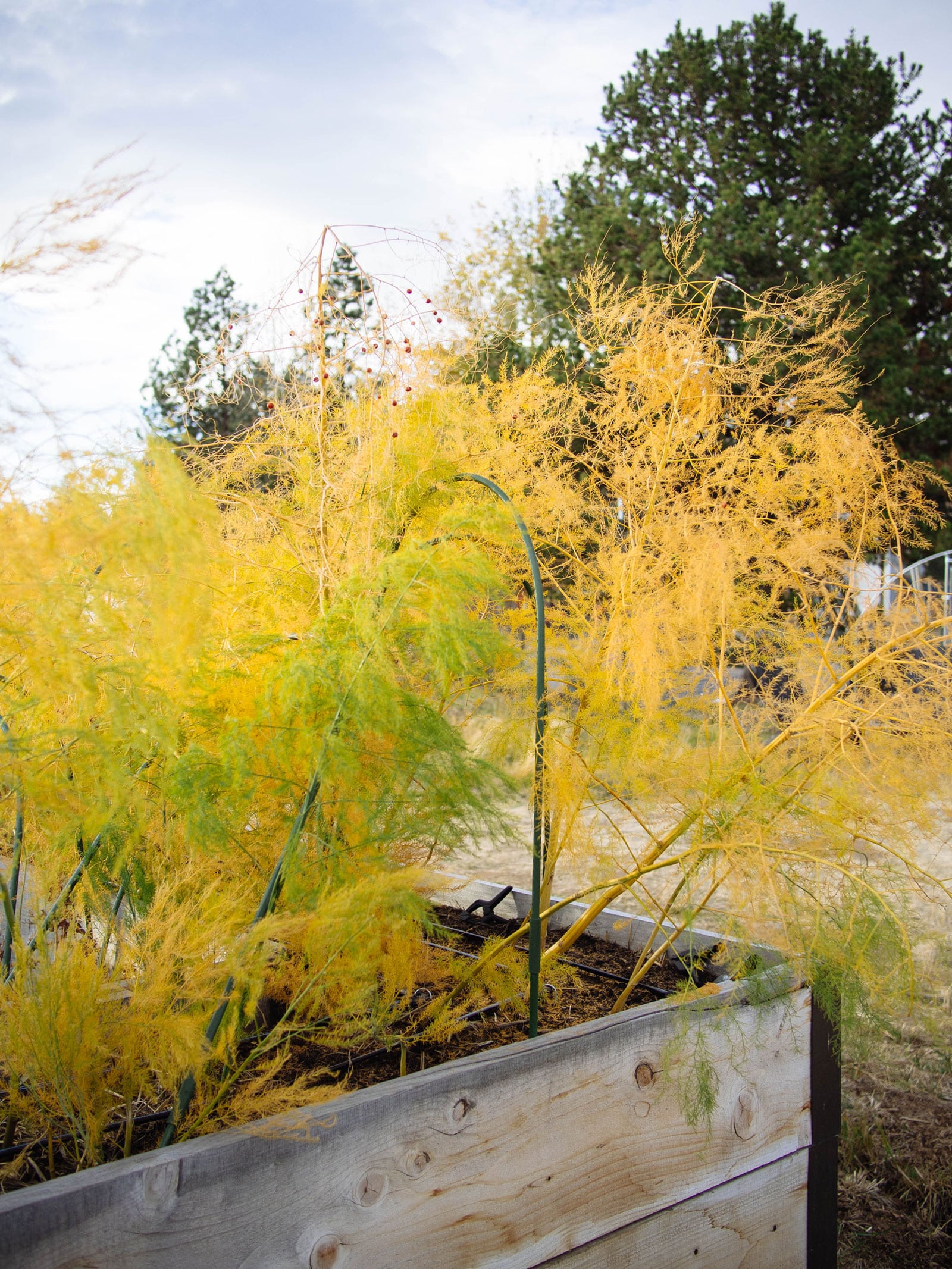
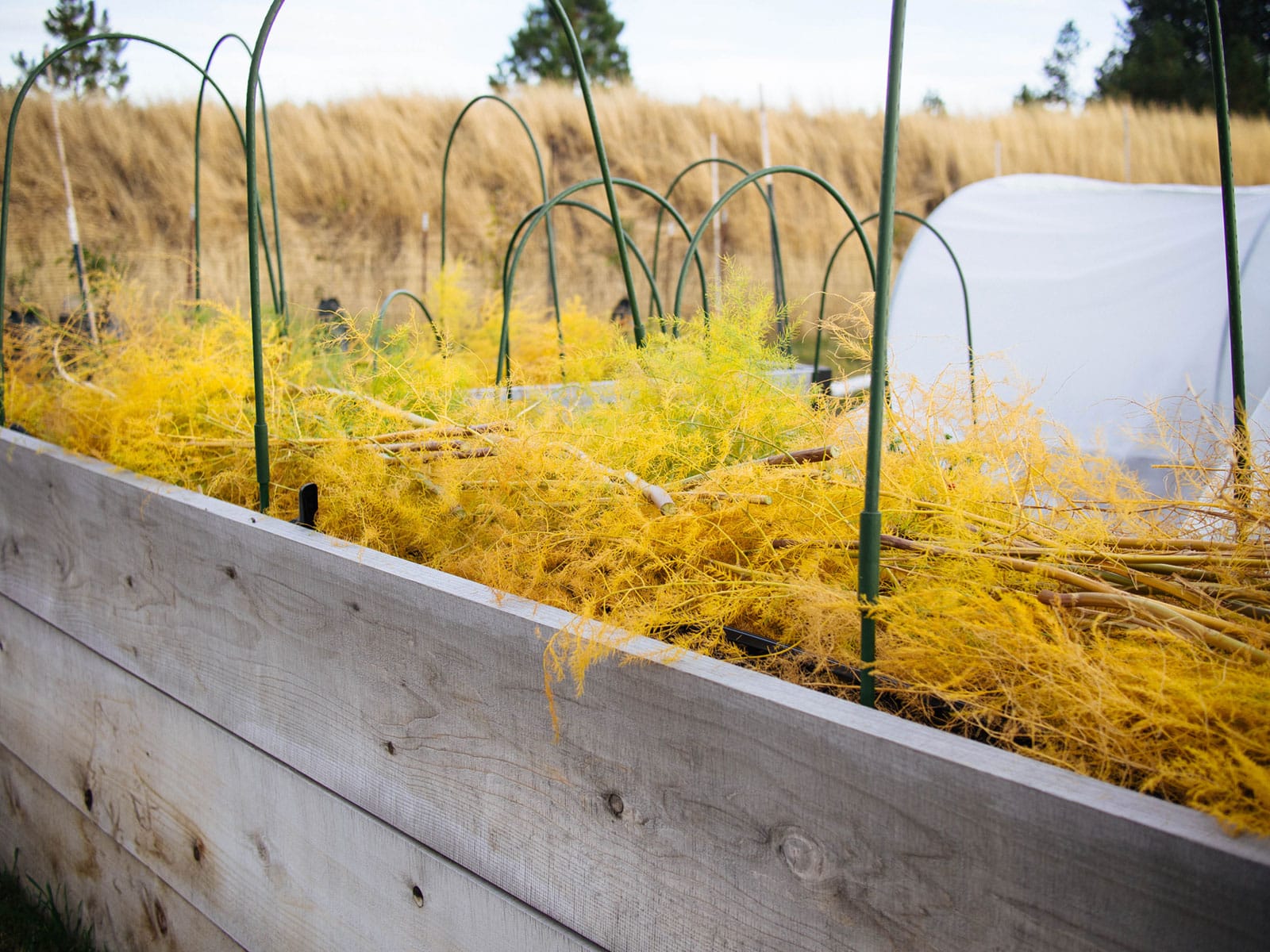
If you had a problem with pests or diseases during the growing season, bag and trash the old foliage; it’s not worth adding to your compost pile, as many home compost piles don’t get hot enough to destroy eggs and pathogens.
You then have the choice of leaving the asparagus bed bare like that, if you get enough snow to cover and insulate the crowns all winter, or mulching the bed.
Mulching is a better option as it’ll protect the crowns from frost heaving if you get an early spring thaw followed by more freezing temperatures. You can use any type of organic mulch, such as straw, dried shredded leaves, wood chips, or pine straw (pine needle mulch).
Cover the bed with 4 to 6 inches of mulch. Once all danger of frost has passed in your area, push the mulch aside to help the asparagus spears emerge sooner. (Don’t worry if you forget to do this; they’ll still grow right through the mulch, but they’ll take a little longer to emerge.)
How long do asparagus typically live?
In the right environment with proper care, asparagus will live for a minimum of 10 years, but often last 20 to 30 years.
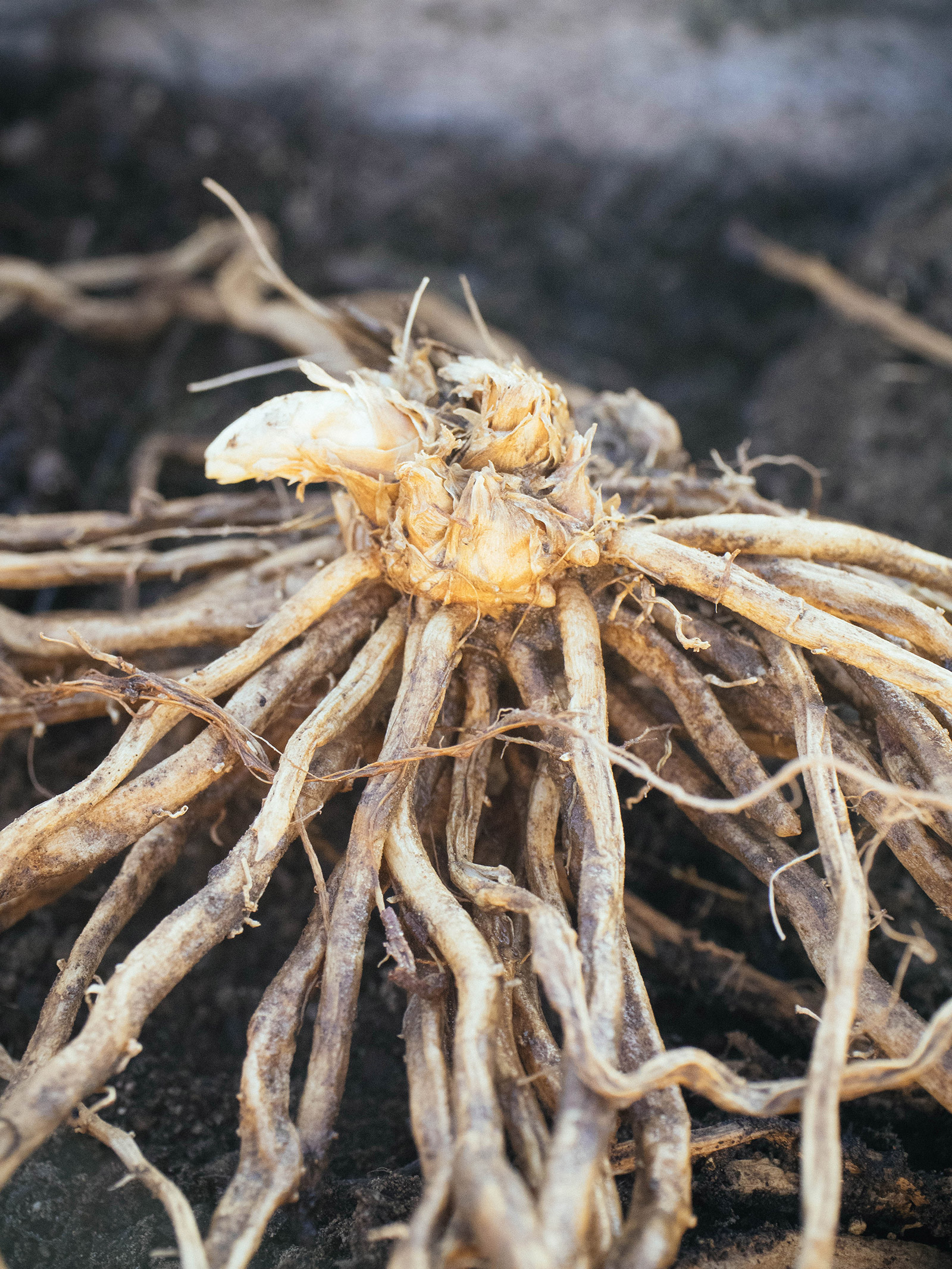
Frequently asked questions
This post updated from an article that originally appeared on May 28, 2021.


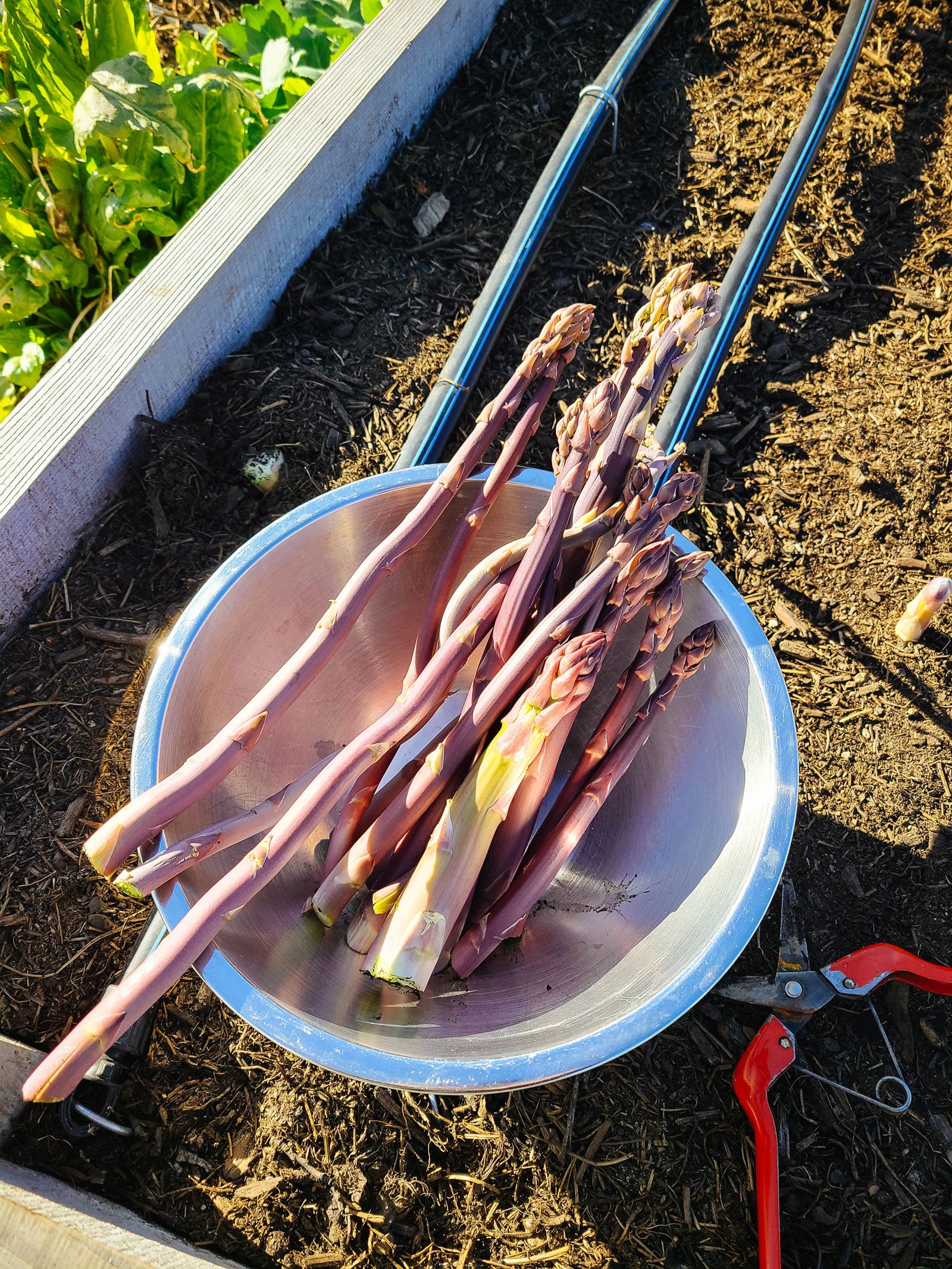













Wow! Super informative article. Thank You so much for sharing your knowledge and experience with us!
This article is very helpful. But I have a dilemma: first year planting, in raised beds, but the soil has settled badly. I need to add almost a foot of garden soil to get the level back to where it needs to be. Will that kill the crowns?
It won’t kill the crowns, but it will force the asparagus to push through more soil to reach the surface. You’ll get larger/thicker spears, but probably fewer of them since the plants have to expend so much energy. Depending on how established your plants are, you might also try digging them up when they’re dormant and replanting them once you refill the soil in your bed. It can be tricky get all of the roots out without damaging the plants though, which is why they usually shouldn’t be moved.
I have more of a question than a comment. This year was rather wet and a lot of grass has grown up in the garden (long after the season). What i the best way to get rid of the grass around the plants? Thank you.
I know practically nothing about growing asparagus. I Planted a couple of plants 2 years ago. The question I have is what happens to the fern fronds and what part of the growth process do they play? Do I cut them down or let them dry on their own? What part of the growing process are they?
Thanks for the help.
The ferns send energy down to the roots. If you re-read this entire article, I talk about what to do after the harvest period is over.
Hello, I have been following your content for a long time, plant planting, care and soil properties, which plants are planted at what time, which plants are planted, which plants are planted in the garden, there are very nice useful information about the garden ehavuz market
I planted crowns last year and they grew tall and healthy. This year they have not yet sprouted. Are the goners or is there still a chance they could come back or be salvaged somehow?
Hello Linda, you have written such an amazing article, full of fantastic information. If you could please help me with this problem, I would be thrilled and thankful. I bought asparagus roots and they sent them too early, even though I asked them not to do so. I wrapped single roots in damped paper towels, and put them in the refrigerator inside a bag. Unfortunately, some grew mold. Is it possible to cut the moldy roots and plant the rest, or do I have to dispose of them?
I was going to plant today but I can’t until I know what to do.
Most appreciative,
Andrea
Hi Linda, I live in South Texas and realized I just planted a whole bed of a cold climate asparagus (Millinneum) yesterday. Trying to decide whether to scrap those and start over or just see how it goes. After researching it almost seems like it just means I eill have a longer growing season? Please help!
Hi Linda. I’m growing asparagus for the first time. i planted 2 year crowns in April and they seem to be growing quite well so far. Most have ferned. However, now the taller spears are starting to tip over. Can I add more soil around the base of the stalks to give them more support? And is it OK to completely cover up some of the shorter stalks? Some of them are very short with fern leaves almost at the current soil level, so it may be difficult to add soil around the taller stalks without covering up the shorter ones alongside. I would appreciate any advice. Thank you!
As a fellow gardener, I definitely would not add more soil. If you added anything, add leafy, mulch, or straw, you could also try a nice webbing around your plants. Using a decorative post and 3 to 4 corners and some nice rope.
Good afternoon.
We have a problem Our asparagus is about 6ft tall with ferns.
We don’t know what to do. Do we cut it down or what.
Help please
James
Will planting asparagus in raised beds work in zone 5? Can’t wait to plant, getting up there in age and I definitely need my garden level raised! Thanks so much for the article!
It’s my plan. Normally I don’t read articles BUT I wanted to get a clear picture as well on bed planting. So in the kids will go with a nice layer of manure 12” below the raised bed top. I too would have liked 3’ beds. What I am using is the Costco double pack of white plastic raised beds. For my i want a living garden. So I can plant a little differently than others in the case of being concerned about how much base asparagus will take. I’ll simply put a 4 x 4 bed here and put it on the bed some else. I’ve also been studying harvest to table.
Asparagus grows in zone 3 to 9, so yes, zone five will work. Mulching is key for your winter coverage.
Hi Linda. I liked the text in the article, but except for the title photo, none of the other photos display. Even downloading the image doesn’t work as it is “damaged”. Can you refresh the mages in the post? (Images and graphics in the ads display just fine.)
Hi Linda – what a great resource. I only wish I’d read it BEFORE I planted asparagus in a couple of stock tanks a couple of weeks ago! So, a couple of questions: I planted my crowns 18″ apart which is what I’d always heard before, but that only gave me five per stock tanks. I’d like to have planted more. Since it was only two weeks ago, do you think I could dig them up and start over? Also, I didn’t fertilize (not sure what I was thinking!). If I dig up and start over, no big deal, I’ll do it then. But if you think I should just leave them only, can I do the fertilizer and kelp now, just mixing them into the top? Thanks!
Hi Linda. So much great info in this article, thank you. I did notice that the link for the Jobe’s Organics (in Asparagus section) isn’t working though. Would you refresh it or add the NPK ratio you suggest so we can decipher which specific J.O’s variety you are referring to?